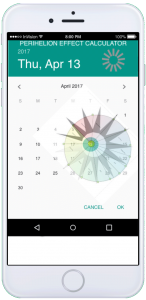Elliptical orbit
The AU is the average distance from the Earth to the sun. Earth makes a complete revolution around the sun every 365.25 days — one year. However, Earth’s orbit is not a perfect circle; it is shaped more like an oval, or an ellipse. Over the course of a year, Earth moves sometimes closer to the sun and sometimes farther away from the sun. Earth’s closest approach to the sun, called perihelion, comes in early January and is about 91 million miles (146 million km), just shy of 1 AU. The farthest from the sun Earth gets is called aphelion. It comes in early July and is about 94.5 million miles (152 million km), just over 1 AU.
Finding the distance
Historically, the first person to measure the distance to the sun was the Greek astronomer Aristarchus around the year 250 B.C. He used the phases of the moon to measure the sizes and distances of the sun and moon. During a half moon, the three celestial bodies should form a right angle. By measuring the angle at Earth between the sun and moon, he determined the sun was 19 times as far from the planet as the moon, and thus 19 times as big. In fact, the sun is about 400 times larger than the moon.
The sun is at the heart of the solar system. All of the bodies in the solar system — planets, asteroids, comets, etc. — revolve around it at various distances. Mercury, the planet closest to the sun, gets as close as 29 million miles (47 million kilometers) in its elliptical orbit, while objects in the Oort Cloud, the solar system’s icy shell, are thought to lie as far as 9.3 trillion miles (15 trillion km).
Earth orbits the sun 100,000 times closer than the Oort Cloud, at an average of 92,955,807 miles (149,597,870,700 meters). The distance from Earth to the sun is called an astronomical unit, or AU, which is used to measure distances throughout the solar system.
Jupiter, for example, is 5.2 AU from the sun. Neptune is 30.07 AU from the sun. The distance to the nearest star, Proxima Centauri, is about 268,770 AU, according to NASA. However, to measure longer distances, astronomers use light-years, or the distance that light travels in a single Earth-year, which is equal to 63,239 AU. So Proxima Centauri is about 4.25 light-years away
Elliptical orbit
The AU is the average distance from the Earth to the sun. Earth makes a complete revolution around the sun every 365.25 days — one year. However, Earth’s orbit is not a perfect circle; it is shaped more like an oval, or an ellipse. Over the course of a year, Earth moves sometimes closer to the sun and sometimes farther away from the sun. Earth’s closest approach to the sun, called perihelion, comes in early January and is about 91 million miles (146 million km), just shy of 1 AU. The farthest from the sun Earth gets is called aphelion. It comes in early July and is about 94.5 million miles (152 million km), just over 1 AU.
Finding the distance
Historically, the first person to measure the distance to the sun was the Greek astronomer Aristarchus around the year 250 B.C. He used the phases of the moon to measure the sizes and distances of the sun and moon. During a half moon, the three celestial bodies should form a right angle. By measuring the angle at Earth between the sun and moon, he determined the sun was 19 times as far from the planet as the moon, and thus 19 times as big. In fact, the sun is about 400 times larger than the moon.
“Aristarchus’ measurement was probably off because first, it is hard to determine the exact centers of the sun and the moon and second, it is hard to know exactly when the moon is half full,” says Cornell University’s astronomy website.
Although imprecise, Aristarchus provided a simple understanding of the sizes and distances of the three bodies, which led him to conclude that the Earth goes around the sun, about 1,700 years before Nicolaus Copernicusproposed his heliocentric model of the solar system.
In 1653, astronomer Christiaan Huygens calculated the distance from Earth to the sun. He used the phases of Venus to find the angles in a Venus-Earth-sun triangle. For example, when Venus appears half illuminated by the sun, the three bodies form a right triangle from Earth’s perspective. Guessing (correctly, by chance) the size of Venus, Huygens was able to determine the distance from Venus to Earth, and knowing that distance, plus the angles made by the triangle, he was able to measure the distance to the sun. However, because Huygens’ method was partly guesswork and not completely scientifically grounded, he usually doesn’t get the credit.
In 1672, Giovanni Cassini used a method involving parallax, or angular difference, to find the distance to Mars and at the same time figured out the distance to the sun. He sent a colleague, Jean Richer, to French Guiana while he stayed in Paris. They took measurements of the position of Mars relative to background stars, and triangulated those measurements with the known distance between Paris and French Guiana. Once they had the distance to Mars, they could also calculate the distance to the sun. Since his methods were more scientific, he usually gets the credit.
“Expressing distances in the astronomical unit allowed astronomers to overcome the difficulty of measuring distances in some physical unit,” astronomer Nicole Capitaine of Paris University told Space.com. “Such a practice was useful for many years, because astronomers were not able to make distance measurements in the solar system as precisely as they could measure angles.”
New equation
With the advent of spacecraft and radar, more precise methods emerged for making a direct measure of the distance between the Earth and the sun. The definition of AU had been “the radius of an unperturbed circular Newtonian orbit about the sun of a particle having infinitesimal mass, moving with a mean motion of 0.01720209895 radians per day (known as the Gaussian constant).”
Along with making things unnecessarily difficult for astronomy professors, that definition actually didn’t jibe with general relativity. Using the old definition, the value of AU would change depending on an observer’s location in the solar system. If an observer on Jupiter used the old definition to calculate the distance between the Earth and the sun, the measurement would vary from one made on Earth by about 1,000 meters (3,280 feet).
Moreover, the Gaussian constant depends on the mass of the sun, and because the sun loses mass as it radiates energy, the value of AU was changing along with it.
The International Astronomical Union voted in August 2012 to change the definition of the astronomical unit to a plain old number: 149,597,870,700 meters. The measurement is based on the speed of light, a fixed distance that has nothing to do with the sun’s mass. A meter is defined as the distance traveled by light in a vacuum in 1 / 299,792,458 of a second.
“The new definition is much simpler than the old one,” said astronomer Sergei Klioner of the Technical University of Dresden in Germany. Both Klioner and Capitaine were both part of the International Astronomical Union group that worked to refine the definition.
https://www.space.com/17081-how-far-is-earth-from-the-sun.html



